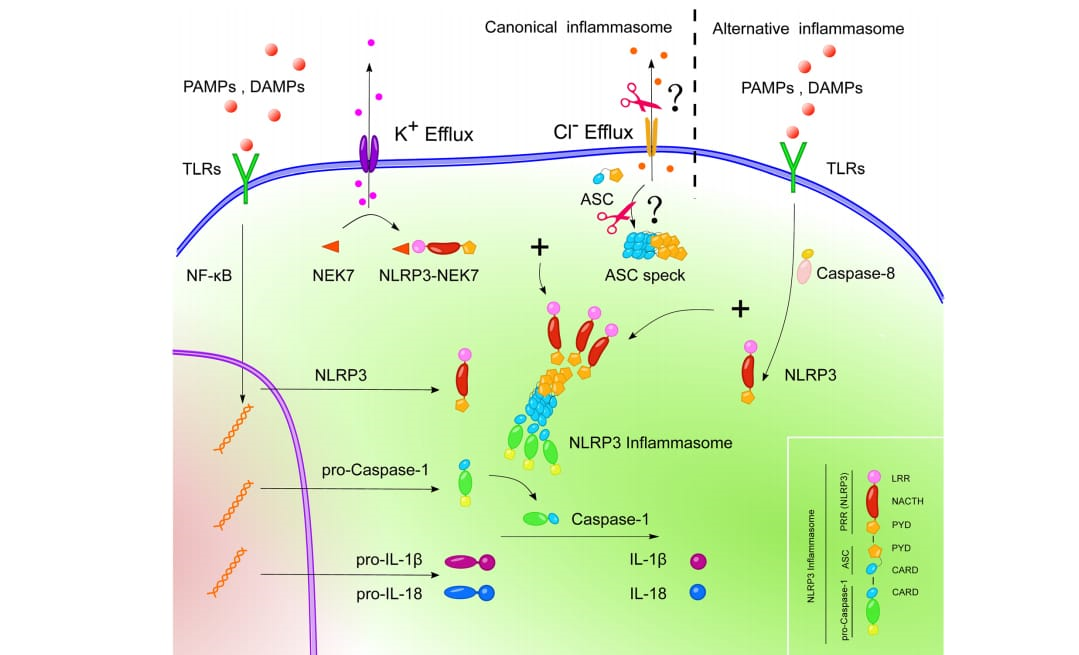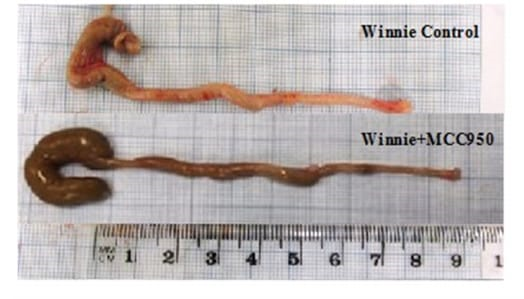MCC950
MCC950 is defined as the specific compound containing diarylsulfonylurea that can be specifically used for the inhibition of the inflammasome by blocking the NLRP3. Inflammasomes are defined as the combination of the multi-protein complex that has a potent role in immunity and inflammation. The major components which are required for the assembly of inflammasome include caspase-1 enzymes, which is a cysteine protease, PRR as a sensor (pattern recognition receptor), and ASC which is defined as the apoptosis-associated CARD. This PRR has three major types of node-like receptors including NLRP1, NLRP3, and NLRC4 along with the AIM2 that are required for the formation of an inflammasome. Among them, NLRP3 inflammasome plays an important role in innate immunity by secreting various kinds of cytokines including IL-1β and IL-18, which triggers the pyroptosis of the cells. It has a tripeptide conformation that consists of the leucine-rich repeats which are involved in the recognition of the stimulus, and pyrin domains which play an important role in the interaction with ASC. This NLRP3-associated inflammasome is activated upon the assembly of NLRP3 components. This activation is initiated via potassium efflux. This increase in the extracellular potassium will lead to the activation of the inflammasome in macrophages which is induced with the help of activating agents of the inflammasome. After it is activated it interacts with the ASC and pro-caspase-1 and forms a multi-protein complex which is referred to as NLRP3. During assembly, chlorine efflux also affects the speck formation or speck oligomerization of ASC via CLIC channels. Different studies explained that NLRP3 is the most important inflammasome which is activated via pathogenic stimulation that in return leads to the occurrence and progression of the diseases via increasing inflammatory processes. These diseases include the development of atherosclerosis, gout, type 2 diabetes Mellitus, etc. A substance or compound which can block the activation of the NLRP3 can be used as a therapeutic drug for the management of the above-mentioned diseases. So MCC950 can be used as a therapeutic agent because it can block the activation of the NLRP3 by inhibiting the cytokines secretion including IL-10 and IL-1β. Moreover, different studies also classified MCC950 into CRIDs which means cytokines release inhibitory drugs. Studies also suggest that due to its inhibitory action, it can be used as a therapeutic drug for diseases that are related to inflammation like spontaneous colitis and cholestasis injuries of the liver.

Figure 1:diagrammatic representation of the NLRP3 assembly
Studies also suggest that MCC950 can also be used for the treatment of Parkinson’s disease. PD is the most common type of neuro-inflammatory disorder in which there is the degeneration of the neuron which are dopaminergic within the substantia nigra. This is due to the inflammasome activation including node-like receptors mainly NLRP3. A study suggests that NLRP3 inflammasome causes an inflammatory response in MPTP-induced mice that in return leads to the dopaminergic degeneration of the neurons. However, the action of other inflammasomes and the activation of the NLRP3 in remaining parts of the brain like the hippocampus is unclear. Different studies explained the treatment of PD but these long-term therapies result in other serious problems. This requires a new active compound or any drug therapy that can address neurodegenerative disorders with minimal side effects. MCC950 can address this issue because it can give protective effects on the degeneration of neuro disorders by inhibiting the inflammasome NLRP3. Moreover, it not only inhibits the inflammasome but also inhibits the active glial cells along with the decrease in the degeneration of neurons.
As we have discussed earlier that it can be used as a therapeutic agent for the treatment of atherosclerosis. One of the studies suggests these Inflammasomes are activated via activation agents. This activation leads to the secretion of the caspase-1 enzyme by cells of the immune system. After that this caspase-1 results in the activation of IL-1β that initiates the inflammatory processes. These inflammatory responses due to IL-1β can be inhibited with the help of canakinumab. But the major problem is that it also increases the cholesterol level within the blood. While MCC950 can decrease the development of atherosclerosis by reducing the adhesion of the monocytes which in turn decreases plaque content without increasing the cholesterol level.
Similarly, it can also be used for liver injuries that are due to cholestasis. As we know the MCC950 has anti-inflammatory activity by blocking the action of NLRP3 inflammasome. Previous studies do not give a clue related to its use in liver injuries but a study conducted on the determination of the therapeutic efficacy of the MCC950 on the cholestasis live injury stated that it has the potential to overcome the effects of inflammasome NLRP3. The study was conducted on the bile duct ligation model of mice. During the study, they noticed that during the obstruction of the bile duct, the level of inflammasome NLRP3 is upregulated. Upon treatment with the MCC950, they noticed that it has the potential to decrease the level of pro-inflammatory cytokines like IL-10 and IL-1β, which would significantly reduce the level of BDL-Liver injury. Moreover, it can also inhibit the infiltration of macrophages that in return cause decreased levels of hepatic cell death. It also inhibits the activation of the NLRP3. Transcriptome analysis also revealed that the protective effect of MCC950 involves toll-tike receptors that help it to inhibit the secretion of interleukins. Not only does it protect against liver injuries, but also inhibits liver fibrosis by inhibiting the activation of the inflammasome by blocking the toll-like receptors that signaling
A present study reported on the use of MCC950 against spontaneous colitis in mice also suggests that it can be beneficial to reduce the level of inflammation by inhibiting the NLRP3. Spontaneous colitis in the mouse mimics ulcerative colitis in humans. That’s why it may be beneficial for humans as well but the studies don’t report its use in human ulcerative colitis. Studies suggest that it inhibits the secretion of IFNγ, IL-1β, IL-17, IL-18, IL1-α, etc. This significantly inhibits the activation of the caspase-1 enzyme due to which the multiprotein complex will not form the NLRP3 will not activate. That in return becomes beneficial for spontaneous colitis.

Figure 2:effect of MCC950 on the colon of Winnie. (mouse).













コメント